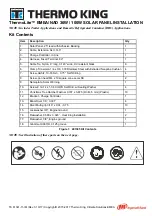
ENG-00178-20P-PPC-E10_User_Manual.docdoc
-10-
Rev 2.0 © 2014 EMAC, Inc.
1.14
I/O Expansion
The Processor used by the PPC-E10 provides a number of unused I/O lines. The PPC-E10 provides access to
these lines on connector HDR1. This 44-pin dual row header contains GPIO lines, SPI bus, I
2
C bus, A/D,
interrupts and power pins. Signal names listed in the table below are the SoM names as defined in the SoM 200
pin specification.
Pin
Signal
Pin
Signal
1
3.3V
2
3.3V
3
GPIO1
4
GPIO4
5
GPIO2
6
GPIO5
7
GPIO3
8
GPIO6
9
INT0
10
GPIO7
11
INT1
12
GND
13
OSC0
14
GND
15
OSC1
16
GND
17
ADC4
18
GND
19
NC
20
GND
21
NC
22
GND
23
NC
24
GND
25
SPI_MISO
26
GND
27
SPI_MOSI
28
GND
29
31
33
35
37
39
41
43
SPI_CLK
SPI_CS3
SPI_CS1
I2C_DAT
I2C_CLK
*SOM_RSTOUT
5V_VCC
GND
30
32
34
36
38
40
42
44
GND
GND
GND
GND
GND
GND
5V_VCC
GND
1.15
Real-Time Clock
The PPC-
E10 is equipped with an external battery for backing up the module’s Real-Time Clock (RTC). Drivers to
access the RTC are included in the operating systems. Jumper JB4 should be placed in the ON position in order
to retain system time when powered down.
1.16
Status LEDs and Reset
The PPC-E10 provides two status LEDs, LD1 (Green) and LD2 (Red). These can be controlled independently via
software (GPIO13 & GPIO12 respectively). LD1 and LD2 are located just to the left of the SD/MMC socket.
Also provided is a Reset Button (PB1). Pressing this button will cause the system to reset.







































